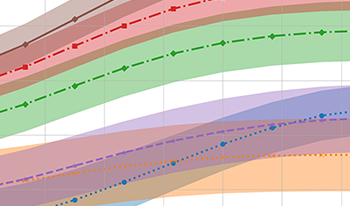References
1BarclayC. D.CuttingJ. E.KozlowskiL. T.1978Temporal and spatial factors in gait perception that influence gender recognitionPerception Psychophysics23145152145–5210.3758/BF03208295
2BarrettR.VonkNoordegraafM.MorrisonS.2008Gender differences in the variability of lower extremity kinematics during treadmill locomotionJ. Motor Behavior40627062–7010.3200/JMBR.40.1.62-70
3BasheerI. A.HajmeerM.2000Artificial neural networks: fundamentals, computing, design, and applicationJ. Microbiological Methods433313–3110.1016/S0167-7012(00)00201-3
4BeardsworthT.BucknerT.1981The ability to recognize oneself from a video recording of one’s movements without seeing one’s bodyBull. Psychonomic Society18192219–2210.3758/BF03333558
5BertenthalB. I.PintoJ.1994Global processing of biological motionsPsychological Science5221225221–510.1111/j.1467-9280.1994.tb00504.x
6BorràsR.LapedrizaÀ.IgualL.
7de BrébissonA.VincentP.
8CaoL.DikmenM.FuY.HuangT. S.
9ChangD. H. F.TrojeN. F.2009Acceleration carries the local inversion effect in biological motion perceptionJ. Vision9191919–10.1167/9.1.19
10ChangD. H. F.TrojeN. F.2009Characterizing global and local mechanisms in biological motion perceptionJ. Vision9888–10.1167/9.5.8
11CivileC.McLarenR. P.McLarenI. P. L.2014The face inversion effect—Parts and wholes: Individual features and their configurationQuarterly J. Experimental Psychology67728746728–4610.1080/17470218.2013.828315
12ClarkR. A.PuaY.-H.FortinK.RitchieC.WebsterK. E.DenehyL.BryantA. L.2012Validity of the Microsoft Kinect for assessment of postural controlGait Posture36372377372–710.1016/j.gaitpost.2012.03.033
13ClarkR. A.PuaY.-H.BryantA. L.HuntM. A.2013Validity of the Microsoft Kinect for providing lateral trunk lean feedback during gait retrainingGait Posture38106410661064–610.1016/j.gaitpost.2013.03.029
14ClarkR. A.BowerK. J.MentiplayB. F.PatersonK.PuaY.-H.2013Concurrent validity of the Microsoft Kinect for assessment of spatiotemporal gait variablesJ. Biomech.46272227252722–510.1016/j.jbiomech.2013.08.011
15CuttingJ. E.KozlowskiL. T.1977Recognizing friends by their walk: Gait perception without familiarity cuesBulletin of the Psychonomic Society9353356353–610.3758/BF03337021
16DavisJ. W.GaoH.2004An expressive three-mode principal components model for gender recognitionJ. Vision4222–10.1167/4.5.2
17DittrichW. H.TrosciankoT.LeaS. E. G.MorganD.1996Perception of emotion from dynamic point-light displays represented in dancePerception25727738727–3810.1068/p250727
18van DiestM.StegengaJ.WörtcheH. J.PostemaK.VerkerkeG. J.LamothC. J. C.2014Suitability of Kinect for measuring whole body movement patterns during exergamingJ. Biomech.47292529322925–3210.1016/j.jbiomech.2014.07.017
19GersF. A.SchmidhuberJ.CumminsF.
20GieseM. A.PoggioT.2003Cognitive neuroscience: neural mechanisms for the recognition of biological movementsNature Reviews Neuroscience417910.1038/nrn1057
21HanJ.BirB.2006Individual recognition using gait energy imageIEEE Trans. Pattern Anal. Mach. Intell.28316322316–2210.1109/TPAMI.2006.38
22HillH.JohnstonA.2001Categorizing sex and identity from the biological motion of facesCurrent Biology11880885880–510.1016/S0960-9822(01)00243-3
23HuangG.WangY.Gender classification based on fusion of multi-view gait sequencesAsian Conf. Computer Vision.2007SpringerBerlin, Heidelberg
24JohanssonG.1973Visual perception of biological motion and a model for its analysisPerception Psychophysics14201211201–1110.3758/BF03212378
25JohanssonG.1975Visual motion perceptionSci. Am.232768976–8910.1038/scientificamerican0675-76
26JohanssonG.1976Spatio-temporal differentiation and integration in visual motion perceptionPsychological Res.38379393379–9310.1007/BF00309043
27KingmaD.BaJ.
28KozlowskiL. T.CuttingJ. E.1977Recognizing the sex of a walker from a dynamic point-light displayPerception Psychophysics21575580575–8010.3758/BF03198740
29LangeJ.LappeM.2006A model of biological motion perception from configural form cuesJ. Neurosc.26289429062894–90610.1523/JNEUROSCI.4915-05.2006
30LeeL.GrimsonW. E. L.Gait analysis for recognition and classificationProc. Fifth IEEE Int’l. Conf. on Automatic Face Gesture Recognition2002IEEEPiscataway, NJ
31MatherG.MurdochL.1994Gender discrimination in biological motion displays based on dynamic cuesProc. R. Soc. B258273279273–910.1098/rspb.1994.0173
32MaY.PatersonH. M.PollickF. E.2006A motion capture library for the study of identity, gender, and emotion perception from biological motionBehavior Res. Methods38134141134–4110.3758/BF03192758
33MaasA. L.HannunA. Y.NgA. Y.2013Rectifier nonlinearities improve neural network acoustic modelsProc. Icml.30
34McKoneE.YovelG.2009Why does picture-plane inversion sometimes dissociate perception of features and spacing in faces, and sometimes not? Toward a new theory of holistic processingPsychonomic Bulletin Review16778797778–9710.3758/PBR.16.5.778
35McGlothlinB.JiacolettiD.YandellL.2012The inversion effect: biological motion and gender recognitionPsi Chi J. Psychological Res.1710.24839/2164-8204.JN17.2.68
36StefanK.MikolovT.KarafiátM.BurgetL.Recurrent neural network based language modeling in meeting recognitionTwelfth Annual Conf. of the Int’l. Speech Communication Association2011
37PascanuR.MikolovT.BengioY.On the difficulty of training recurrent neural networksInt’l. Conf. on Machine Learning2013
38PavlovaM.SokolovA.2000Orientation specificity in biological motion perceptionPerception Psychophysics62889899889–9910.3758/BF03212075
39PfisterA.WestA. M.BronnerS.NoahJ. A.2014Comparative abilities of Microsoft Kinect and Vicon 3D motion capture for gait analysisJ. Medical Engineering Technol.38274280274–8010.3109/03091902.2014.909540
40PhinyomarkA.OsisS. T.HettingaB. A.KobsarD.FerberR.2016Gender differences in gait kinematics for patients with knee osteoarthritisBMC Musculoskeletal Disorders171210.1186/s12891-016-1013-z
41PollickF. E.VaiaL.JungwonR.ChoS.-B.2002Estimating the efficiency of recognizing gender and affect from biological motionVision Res.42234523552345–5510.1016/S0042-6989(02)00196-7
42PollickF. E.KayJ. W.HeimK.StringerR.2005Gender recognition from point-light walkersJ. Experimental Psychology: Human Perception and Performance31124710.1037/0096-1523.31.6.1247
43RosenblattF.1958The perceptron: a probabilistic model for information storage and organization in the brainPsychological Review6538610.1037/h0042519
44SaundersD. R.WilliamsonD. K.TrojeN. F.2010Gaze patterns during perception of direction and gender from biological motionJ. Vision10999–10.1167/10.11.9
45SaundersD. R.SuchanJ.TrojeN. F.2009Off on the wrong foot: Local features in biological motionPerception38522532522–3210.1068/p6140
46ShiY.XiaochiM.ZhengM.JiahuanW.NailangY.QuanG.WangC.GaoZ.2018Using a Kinect sensor to acquire biological motion: Toolbox and evaluationBehavior Research Methods50518529518–2910.3758/s13428-017-0883-9
47SimionF.RegolinL.BulfH.2008A predisposition for biological motion in the newborn babyProc. National Academy of Sciences105809813809–1310.1073/pnas.0707021105
48SivapalanS.ChenD.DenmanS.SridharanS.FookesC.Gait energy volumes and frontal gait recognition using depth images2011 Int’l. Joint Conf. on Biometrics (IJCB)2011IEEEPiscataway, NJ161–6
49SumiS.1984Upside-down presentation of the Johansson moving light-spot patternPerception13283286283–610.1068/p130283
50TrojeN. F.2002Decomposing biological motion: A framework for analysis and synthesis of human gait patternsJ. Vision2222–10.1167/2.5.2
51TrojeN. F.WesthoffC.2006The inversion effect in biological motion perception: Evidence for a ‘life detector’?Current Biol.16821824821–410.1016/j.cub.2006.03.022
52YinR. K.1969Looking at upside-down facesJ. Experimental Psychology8114110.1037/h0027474
53YuS.TanT.HuangK.JiaK.WuX.2009A study on gait-based gender classificationIEEE Trans. Image Process.18190519101905–1010.1109/TIP.2009.2020535
54PalaciosA. A.Neuromimetic intelligenceLorraine Laboratory of Research in Computer Science and its Applications2012French Institute for Research in Computer Science and Automation

 Find this author on Google Scholar
Find this author on Google Scholar Find this author on PubMed
Find this author on PubMed